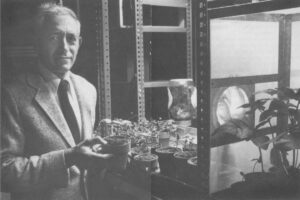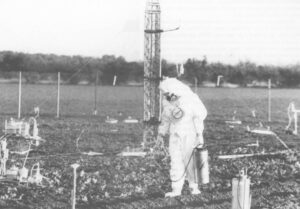Yvonne Baskin
- 1987

Fellowship Title:
- The release of genetically engineered organisms into the environment
Fellowship Year:
- 1987

The Future
A biologist at the University of California, Los Angeles likes to tell colleagues about the fellow who came to his Topanga Canyon home to repair a propane tank. Biologist and repairman chatted. When the biologist mentioned his work on the genetic engineering of plants, the repairman became acutely interested. Yes, the biologist explained, we’re looking at ways to alter things like seed proteins–say, to make rice or corn produce all 20 amino acids that humans need. Or increase the solid content of fruit, perhaps to make a tomato that yields more tomato paste per pound. Or change the proteins in flowers to create a purple poinsettia or a blue rose for the ornamental market. That evening. a stretch limousine pulled up in front of the biologist’s house. Out stepped the repairman, followed by several hippies, then a few men in three-piece suits. Once inside the house, one of the visitors “slapped some green matter onto the table,” the biologist recalls. Then he said: “Can you increase the alkaloid component of these leaves?” The plant was

How Government Regulates a Life
The average new drug costs $80 million to develop and another $40 million to safety test before it passes federal scrutiny and reaches the market. A new agricultural chemical costs about $70 million to develop and $15 million to safety test. In contrast, a seed company typically invests only half a million dollars to develop a new line of corn. And it is not required to spend anything on safety testing. “Traditionally, our industry hasn’t spent infinite millions on all possible predictive safety tests until we’ve had good reason to think there could be a problem,” says Dr. Ronald L. Meeusen, manager of agricultural biotechnology at the Rohm & Haas Research Laboratories in Spring House, Pennsylvania. New varieties of corn, tomatoes, cattle or even agriculturally useful microorganisms bred by traditional methods or mutated by radiation or chemicals typically reach the market with little or no attention from government. But the United States has taken a different approach to living creatures altered by recombinant DNA techniques. In 1984, shadowed by a decade of public apprehension about

How Will New Genes Behave – Like Microbial Poodles or Gypsy Moths?
Leading the way into the back room of his Cornell University laboratory, insect ecologist David Pimentel taps at the plexiglas walls of a chamber the size of a dishwasher. Inside this giant terrarium. Sucking obliviously at the stems of cowpeas are crowds of aphids, which are plant lice the size of pinheads. The government of Indonesia has asked Pimentel to find natural predators to combat two aphids plaguing the islands’ soybean crops. But the Indonesians want to be fairly certain they are not swapping one pest for-another. Beetles and wasps battle plant lice in artificial worlds created by insect ecologist David Pimentel. (Photos courtesy Cornell University News). So Pimentel will try out each candidate–ladybird beetles and tiny parasitic wasps–by, letting them wreak havoc in the artificial world of these plexiglas “microcosms.” Even his testing is complicated by the fact that neither the United States nor Indonesia wants the other nation’s aphids, wasps or beetles imported, even for well-intentioned research. So the aphid victims in his lab are surrogates from Georgia. Few biologists today would question

Testing The Future
In the early morning darkness last April 24, guided by the light from a row of car headlights, a dozen people swarmed over a strawberry patch the size of two tennis courts, setting out hundreds of plastic Petri dishes and mounting equipment on steel towers. Five times as many of us, reporters and television crews from as far afield as Tokyo, massed outside a chain link fence, shivering in the predawn chill. As dawn broke a single protester representing Earth First! arrived from San Francisco, 50 miles to the west. Surrounded by cameras, he lauded vandals who had uprooted strawberries in the tiny plot only hours before and proclaimed that a hazardous travesty was about to occur. In a parody of his dire but long-familiar predictions, a public relations firm hired by Advanced Genetic Sciences (AGS) passed out buttons to the media: “I Survived Frostban, Brentwood, CA 1987.” Back inside the fence, with dozens of cameras now focused on her, AGS scientist Julie Lindemann donned a white plastic “moonsuit” and respirator–a bit of admitted over-drama
